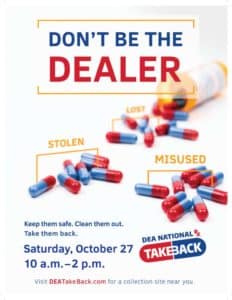 Semi-Annual event provides safe, convenient, and responsible way to dispose of prescription drugs
Semi-Annual event provides safe, convenient, and responsible way to dispose of prescription drugs
The Drug Enforcement Administration is hosting the semi-annual National Prescription Drug Take Back Day on Saturday, Oct. 27. The goal of the event is to provide a safe, convenient, and responsible means of disposing of prescription drugs, while also educating the general public about the potential for abuse of medications. For a list of local drug collection sites, click here.
The Council on Recovery urges you to check your medicine cabinets, drawers, purses, and glove boxes for unused and/or expired Rx prescriptions. Dispose of them safely and immediately. Drug Take Back day is an ideal time to assure that dangerous, addictive, and potentially deadly prescriptions do not fall into the wrong hands.
If you or a loved one is experiencing a problem with Rx drugs, alcohol, or other addictive behaviors, contact The Council. We can help!

 Semi-Annual event provides safe, convenient, and responsible way to dispose of prescription drugs
Semi-Annual event provides safe, convenient, and responsible way to dispose of prescription drugs